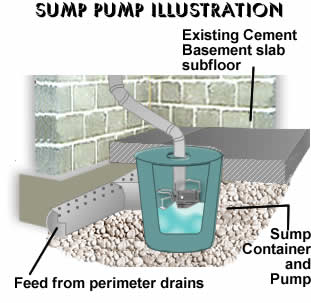|
LEARNING ABOUT SUMP PUMPS!

Sump pumps play an important role in the waterproofing process
when an internal water management system is used.
The sump pump is placed beneath the basement sub-floor at the
lowest point of the drainage system so that all of the water
captured in the perimeter drainage pipes flows toward the pump by
means of gravity feed.
Once the water reaches the sump pump tank which houses the sump
pump, it is then pumped outside through a pipe that exits the
basement above the sill of your home's foundation.
As explained in our section on
basement waterproofing methods, this approach is the
least intrusive to the foundation and does not require penetrating
the foundation, or an extensive excavation outside the foundation in
order to divert the water, as would be the case with a system
entirely reliant upon gravity feed alone.
The water is pumped out and then led through a pipe not far below
the ground, carrying it to a safe distance away from the foundation.
This process prevents the water table from ever reaching the
level of the basement sub-floor.
The sump pump will not activate until the water in the sump pump
tank reaches what is known as "the critical level". When this
level has been reached, the sump pump will automatically turn on and
begin to pump the water out.
It can be seen from this how important it is that a powerful,
reliable sump pump is used, and that the sump pump include a battery
backup unit in the event of a power failure.
There are several other factors that should be taken into
consideration when selecting and installing a sump pump.
You may rest assured that Rain King will effectively and
successfully address each of these concerns during the process of
waterproofing your basement.
| Learn more about Rain King's
Sump Pump solutions! |
 |
|